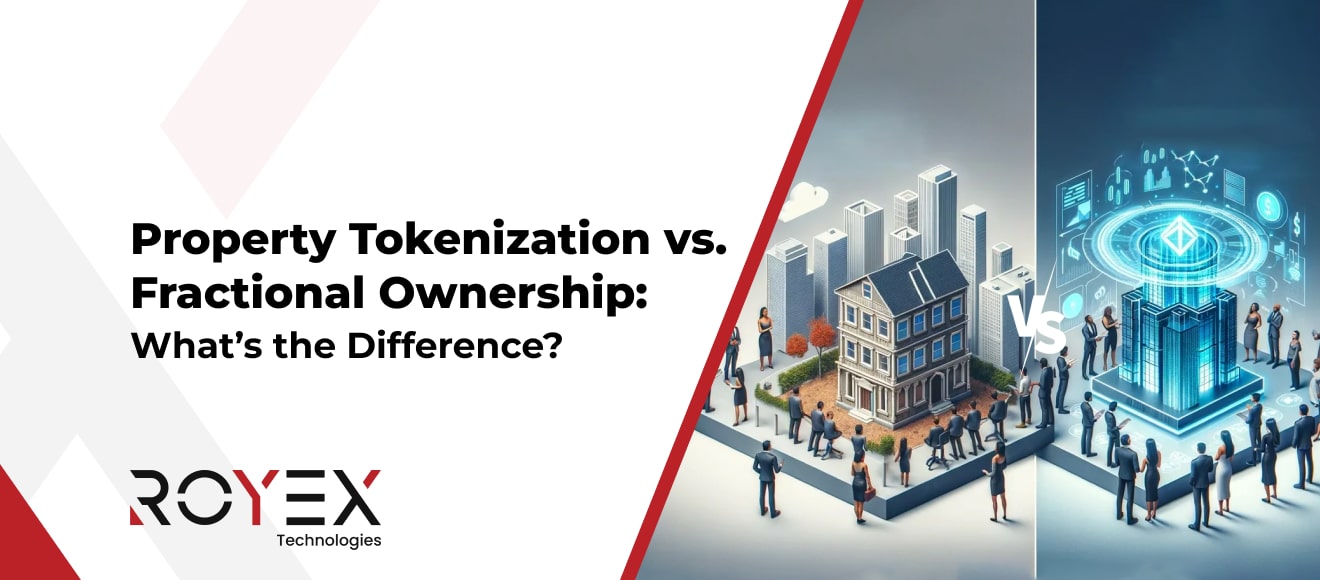
Property Tokenization vs. Fractional Ownership: What’s the Difference?
Introduction
The real estate industry has historically been one of the most secure and profitable forms of investment. Properties tend to appreciate over time, provide consistent rental income, and offer a tangible asset that investors can hold for years. Yet for decades, owning investment property was limited to the wealthy—the cost of entry was high, liquidity was low, and management was complex.
In the last decade, technology-driven investment models have emerged to break down these barriers. Two of the most promising approaches are:
-
Fractional Ownership – where investors purchase a share of a property via a legal ownership structure, such as an SPV.
-
Property Tokenization – where real estate ownership rights are represented as digital tokens on a blockchain.
While both models aim to make property investment more accessible, affordable, and efficient, they differ significantly in terms of legal structure, technology, liquidity, regulation, and investor experience.
In this detailed guide, we’ll unpack the differences between fractional ownership and property tokenization, compare the advantages and limitations of each, and analyze real-world examples like PRYPCO, Stake, and GetStake—all operating successfully in the UAE’s rapidly evolving proptech market.
1. Why These Models Are Disrupting Real Estate Investment
Historically, the challenges of traditional property investment included:
-
High Capital Requirement – Buying even a small apartment in a prime location often requires hundreds of thousands of dollars upfront.
-
Low Liquidity – Selling a property can take months, if not years.
-
Geographic Restrictions – Investors are often limited to their own country due to legal and tax complexities.
-
Management Overhead – Maintenance, tenant management, and legal compliance require significant effort or outsourcing.
Both fractional ownership and tokenization address these pain points:
-
Lower Entry Thresholds – You can start investing with as little as AED 500 (Stake/GetStake) or AED 2,000 (PRYPCO).
-
Portfolio Diversification – Instead of putting all your capital into one property, you can own parts of many.
-
Global Participation – Especially with blockchain tokenization, international investors can participate without complex cross-border transactions.
-
Digital Management – Platforms handle everything from property acquisition to rental income distribution.
A 2024 PwC PropTech Survey found that 71% of millennial investors would consider digital property investment if the entry point was below $1,000, and 62% said liquidity was a deciding factor—two needs that these models directly address.
2. Defining the Concepts
2.1 What is Fractional Ownership?
Fractional ownership in real estate is a shared ownership model where multiple investors collectively own a property. Instead of one person holding the entire title, each investor owns a proportionate share—either directly on the property title or indirectly via a legal entity.
Common Structures:
-
SPV-Based – The most common in regulated markets. A Special Purpose Vehicle (company) is created to own the property, and investors own shares in that SPV.
-
Tenancy-in-Common (TIC) – Multiple individuals directly hold undivided interests in the property (less common in large-scale platforms).
-
Co-Ownership Agreements – Private contracts among a group of investors (popular in small investor circles).
Key Features:
-
Ownership Rights – Investors have a legal right to rental income and appreciation proportional to their share.
-
Income Distribution – Typically paid quarterly or annually.
-
Exit Mechanisms – Can include fixed sale windows, buyback options, or sale of the underlying property.
-
Regulation – Governed by corporate and property laws in the jurisdiction where the SPV is registered.
Case Example – GetStake:
-
Minimum investment: AED 500.
-
Each property is purchased via an SPV in the DIFC.
-
Investors receive quarterly rental income and capital gains when the property is sold.
-
Operates under the Dubai Financial Services Authority (DFSA) for regulatory compliance.
2.2 What is Property Tokenization?
Property tokenization is the digital representation of ownership rights in real estate as tokens on a blockchain. These tokens can be bought, sold, and traded, much like cryptocurrency, but they are tied to real-world assets.
Key Features:
-
Blockchain Ledger – Ownership records are stored on an immutable, distributed ledger.
-
Smart Contracts – Automate dividend payments, ownership transfers, and compliance checks.
-
Fractionalized Digital Units – Properties can be divided into thousands of tokens, each representing a small fraction of the asset.
-
Secondary Market Liquidity – Tokens can potentially be traded instantly on exchanges, subject to regulations.
Case Example – PRYPCO:
-
Uses blockchain to tokenize Dubai properties into “Blocks” starting at AED 2,000.
-
Token holders also receive Dubai Land Department (DLD) Token Ownership Certificates—bridging blockchain with government recognition.
-
Automates monthly rental distribution via smart contracts.
-
Achieved a record by selling out a Dh1.75 million tokenized villa in under five minutes.
3. PRYPCO vs. Stake/GetStake – How They Operate
|
Feature |
PRYPCO (Tokenization) |
Stake / GetStake (Fractional Ownership) |
|
Legal Structure |
Blockchain tokens + DLD certificate |
SPV registered in DIFC / other jurisdictions |
|
Minimum Investment |
AED 2,000 |
AED 500 |
|
Liquidity |
Potentially instant (secondary blockchain market) |
Limited to platform exit windows |
|
Technology |
Smart contracts, blockchain wallets |
Traditional web platform, databases |
|
Regulatory Body |
DLD token recognition, potential VARA oversight |
DFSA / local financial regulators |
|
Income Payout |
Monthly via blockchain |
Quarterly via bank transfer |
|
Investor Base |
Potentially global |
Regionally restricted (due to compliance) |
4. Advantages & Limitations
4.1 Fractional Ownership (SPV-Based)
Advantages:
-
Legally straightforward in most countries.
-
Easier for traditional investors to understand.
-
No need for blockchain wallet setup.
-
Proven SPV legal framework with property law backing.
Limitations:
-
Lower liquidity compared to tokenization.
-
Legal setup required per property (time and cost).
-
Often limited to domestic or regional investors.
4.2 Property Tokenization
Advantages:
-
Potential for global investor participation.
-
Instant peer-to-peer transactions possible.
-
Reduced legal setup per property once framework is in place.
-
Greater transparency via blockchain.
Limitations:
-
Regulatory frameworks are still developing.
-
Requires investor familiarity with blockchain.
-
Jurisdictional differences in token recognition.
5. Technical Architecture Deep Dive
Fractional Ownership Platform Tech Stack
-
Frontend: React.js / Vue.js
-
Backend: Laravel / Node.js
-
Database: PostgreSQL
-
Payments: Stripe, Checkout.com
-
KYC/AML: Sumsub, Onfido
-
Hosting: AWS / Azure
Property Tokenization Platform Tech Stack
-
Frontend: Next.js + Web3 integration
-
Backend: Node.js / NestJS
-
Blockchain: Ethereum / Polygon
-
Smart Contracts: Solidity
-
Wallet Integration: MetaMask, WalletConnect
-
Payments: Fiat + crypto gateways
-
KYC/AML: Blockchain-integrated ID verification
-
Hosting: AWS with blockchain node integration
6. Development Cost & Timeline
|
Model |
MVP Development |
Full-Featured Platform |
Timeline |
|
Fractional Ownership |
$40K – $70K |
$100K – $180K |
4–6 mo |
|
Tokenization |
$50K – $80K |
$120K – $200K |
4–8 mo |
7. Monetization Models
Fractional Ownership:
-
Acquisition fees from sellers.
-
Management fees on property value.
-
Performance fees on capital gains.
Tokenization:
-
Token issuance fees.
-
Transaction fees on secondary markets.
-
Premium property listing fees.
8. Which Model Should You Choose?
Choose Fractional Ownership if:
-
Your market is conservative and not blockchain-ready.
-
Regulations for SPVs are clear.
-
Your investor base prefers bank transfers over crypto.
Choose Tokenization if:
-
You want to attract global investors.
-
Your market has blockchain-friendly laws.
-
Liquidity and instant trading are priorities.
Conclusion
Both fractional ownership and property tokenization are transforming the way people invest in real estate. PRYPCO is pioneering blockchain tokenization with government integration, while Stake and GetStake are scaling SPV-based fractional models within regulated environments.
At Royex Technologies, we develop both types of platforms—from blockchain-based tokenization systems to SPV-backed fractional investment portals—tailored to your market, compliance needs, and growth strategy.





